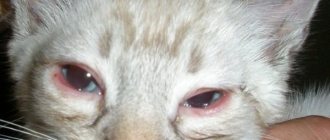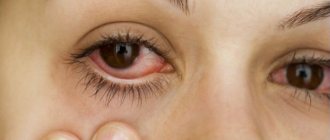It is known that sour eyes in kittens is a normal phenomenon that goes away as the pet grows older. This is due to the fact that babies do not yet know how to wash themselves thoroughly. The owner must come to the rescue by providing good care for the cat. However, sometimes the reason lies in pathological processes occurring in the body. In this situation, you cannot do without consulting a veterinarian. The veterinarian will prescribe the necessary treatment and procedures that will help the kitten overcome the disease.
Health Hazard
Discharge from the eyes is a clear sign that indicates the presence of an infection in the body. Ignoring the first symptoms and untimely treatment can negatively affect the body of a small pet. Without treatment, it can lead to complete loss of vision.
Attention! Pus is normal for newborns. However, greenish or light gray discharge with a strong unpleasant odor indicates serious problems in the body. You should contact your veterinarian as soon as possible.
Owner's first aid
Of course, when a cat has suppuration, a veterinarian’s consultation is necessary. Only after an examination can a veterinarian make an accurate diagnosis and prescribe appropriate treatment. However, the owner must also be able to provide first aid carried out at home. First of all, rinsing is necessary.
Eye wash
How can you wash your eyes?
- Decoction of chamomile flowers.
- Boric acid solution (2 teaspoons of medicine per half liter of warm boiled water).
- 0.02% solution of furatsilin.
How to wash?
The basic rule: the solution must be warm, you cannot use it hot so that the animal does not get burned. A cotton pad, previously twisted into a tourniquet, is dipped into the medicine, which is then squeezed onto the cat’s diseased organ. You need to wash until all the pus is removed. After each wash, the cotton pads should be changed; it is best if the tourniquet is disposable.
You cannot use dry cotton wool, as it can further injure the eye. You should not replace a cotton pad with cotton swabs. Of course, they are more convenient to use, but the sticks pick up a small amount of solution. After you have finished rinsing, you need to put 1% Tetracycline ointment behind the eyelid.
We use ointment
How to properly apply revive ointment?
Before applying the ointment, it must be warmed in your hands; there is no need to make investments with a cold composition:
- One person holds the cat tightly, lying on his side.
- The other, meanwhile, carefully pulls back the animal's lower eyelid.
- Use a special spatula to apply ointment to the lower eyelid.
- Then you need to close the eye and distribute the ointment with light massaging movements.
We use drops
What drops can be used to bury a cat?
In order to treat a cat, you can use different drops, for example, Levomycetin, Sodium Sulfacyl, Diamond Eyes drops.
This is interesting: Do cats have distemper and its symptoms?
How to carry out the procedure correctly?
- The cat needs to be laid on its side, and in such a way that the eyeball is directed upward.
- In order to administer the drops, you need to hold your pet firmly so that it does not get injured.
- Drop the medicine, after which the cat will blink vigorously, and the medicine will be distributed in the eyeball.
- Then blot the area with a napkin.
Why do kitten eyes fester?
Before you begin treating your kitten, it is important to identify why the kitten’s eyes are purulent. All the main reasons can be divided into two groups:
- Mechanical reasons. These can be wounds, specks, bruises, eyelid inversions and many other harmless phenomena. Newborns can involuntarily injure each other with small claws, fall out of the bed, and so on. If renovation work is going on in the house, clouds of dust rise up in the room, which get into the eyes and cause inflammation. Tobacco smoke works on the same principle. Older cats begin to lead an active lifestyle: they play and fight. Entertainment becomes the main cause of scratches and various injuries.
- Diseases. Viral infections, conjunctivitis, chlamydia, blepharitis, allergies and much more. They are transmitted from the mother, through milk, or acquired through improper care and feeding. Stray cats are more likely than domestic cats to have viral diseases of the eyeballs.
Reference. British scientists have concluded that conjunctivitis in one third of kittens is caused by chlamydia. The viral disease occurs in furry fidgets aged 1 to 9 months. Chlamydia is transmitted to healthy kittens by contact from infected kittens.
Prevention
To prevent such a situation, preventive measures are taken:
- The animal is kept in a clean room.
- If a kitten gets dirty, it must be washed.
- Be sure to wash the tray, since dirt accumulated there can cause various problems.
- If an animal is walking outside, it is carefully examined after returning home.
- It is recommended to prevent contact with street animals.
When souring occurs, it is necessary to determine the cause and take appropriate measures. Remember that only a veterinarian can make the correct diagnosis and prescribe treatment. Don't forget to maintain good ear hygiene.
Symptoms of suppuration
Suppuration is visible to the naked eye. Usually the pus dries out and forms a light gray crust. Dried drops form on the fur in the area of the eyes and nose. Too much discharge can even “glue” the eye and it will not open. Kittens will try to remove the formations by washing, but this can only worsen the situation: the infection will spread, and the results will not be the most pleasant.
The pus may be white, yellow, green, or brown. It is important to pay attention if your pet frequently blinks or squints, rubs its eyes with its paws, or sneezes. Older kittens may hide in secluded places. If the baby was active and playful, but suddenly became apathetic, then this is a clear reason to examine him and see a doctor.
Symptoms can tell what disease the kitten’s body has been exposed to. Here are the most common:
- Sour eyes, snot, inflamed and red eyelids. Reason – conjunctivitis. It is divided into four groups according to the nature of the disease.
- Infection occurs against the background of irritation of the mucous membrane (dust, chapping, other external irritants).
- Viral is a symptom of a contagious disease that develops covertly or acutely.
- Chronic occurs when the eyes are dry, the nasolacrimal ducts do not work properly, and ulcers form on the corneas.
- Allergies develop against the background of constant stimulation of the immune system by allergens.
- Purulent eyes, severe runny nose, wet cough, sneezing, upset stomach. The cause is toxoplasmosis , a parasitic disease. Usually occurs in outdoor kittens.
- Swelling, severe pain, the kitten reacts sharply to any touch in the eye area. The reason is blockage of the tear ducts . Usually occurs in babies up to three weeks of age. Pain and discomfort are caused by the accumulation of pathological exudate in the lacrimal canal.
- Swollen eyes, sneezing, coughing, purulent discharge. The cause is chlamydia . The infection affects not only the mucous membranes of the eyes, but also the respiratory tract, digestion and genitals.
- Purulent eyes, cough, rhinitis. The cause is mycoplasmosis . The infection first affects the organs of vision, and then the respiratory system. If treatment is not started in time, the kitten will develop diseases of the genitourinary system, liver and joints.
- Your eyes hurt, tears flow, your eyelids swell. The owner observes that the animal has inflamed eyes, eyelids stuck together from pus and ichor, bleeding and bruising are possible. The reason is injuries . It is important to start treatment in a timely manner, otherwise bacteria will penetrate through small wounds.
Important! Examine a kitten's eyes only with clean hands. It is recommended to wash your hands with laundry soap or disinfect with hydrogen peroxide. This way you can prevent the introduction of even more dangerous viruses.
What to do if you are injured?
Cats are quite attentive to their eyes, avoiding dust or foreign objects. However, freely walking outside is a factor that increases the risk of injury. In addition to dust and dirt, on the street an animal may encounter insects getting into its eyes, or damage its cornea during a conflict with a fellow animal.
Eye injuries in cats are accompanied by redness and tearing. Usually this does not affect the animal’s behavior in any way; the cat does not lose its appetite and behaves as before. The appearance of microtraumas or scratches on the cornea is accompanied by the release of liquid exudate. At the same time, there remains a risk of eye infection and the development of conjunctivitis.
It’s easy to help your pet at home; just rinse the eyes with water or decoctions of medicinal herbs. For minor injuries, this is sufficient; for severe injuries, it is recommended to use antibacterial drops to prevent infection. You cannot administer medications to cats on your own; you should call your veterinarian and check the list of approved medications.
If your cat's eyes are sour, follow these steps:
- Remove crusts around the eyes.
- Rinse eyes and skin around them with water.
- Carry out antiseptic treatment.
- Use drops.
To cleanse the eyes and skin around them, you can use plain water, weak green tea, decoctions of chamomile, calendula or St. John's wort (1 spoon of the plant per glass of water). Medications include furatsilin (1 tablet per glass of water), a weak solution of manganese, or any antiseptic diluted with water in a ratio of 1:5. Treatment is carried out twice a day; in addition, you should use drops with anti-inflammatory properties from a veterinary pharmacy.
It is necessary to consult a doctor if after 2-3 days of treatment the symptoms have not decreased.
Source
Treatment
You cannot do without a visit to the veterinarian. A specialist will examine the kitten’s sore eyes and find out the causes of suppuration. Sometimes it is impossible to establish an accurate diagnosis with the help of an initial examination. In this case, the veterinarian will refer you for additional diagnostics. More experienced doctors will take tests and give an accurate diagnosis. Only after this can effective treatment begin.
Attention! Viral causes of eye suppuration are difficult to treat with folk remedies. Therefore, all “grandmother’s” methods are suitable only as a preventive measure or to accelerate recovery from mechanical damage to the tissue around the eyes.
Recommended drugs
Here are the most popular eye medications for kittens recommended by doctors:
- Tsiprolet. The active substance is ciprofloxacin. It has a local bactericidal and anti-inflammatory effect. Effective against eye damage from infections and microorganisms. For example, staphylococcus, Pseudomonas aeruginosa, chlamydia. This is a prophylactic agent that is used in the initial stages of suppuration. Dosage – 1 drop 3-4 times a day. If persistent purulent and mucous discharge is observed, the dose is increased.
- Levomycetin. The antibiotic drug kills bacteria that are resistant to penicillin and its derivatives. It can cure a kitten’s eyes from conjunctivitis, blepharitis and keratitis. This is a well-known effective antibiotic with positive reviews.
- Diamond eyes. The active ingredients are chlorhexidine and taurine. It is used for all types of conjunctivitis and degenerative changes in the retina. Drops are a good preventative against cataracts. The dosage depends on the duration of treatment: 1 drop per day – 45 days, 2 drops per day – 20 days, 3 drops per day – 10 days.
- Leopard. The active substances are chloramphenicol and furatsilin. The drug has extensive antibacterial effects and provides good relief from conjunctivitis, keratitis and blepharitis. Dosage – 1-2 drops 3-4 times a day.
- Iris. The main antibacterial substance is gentamicin sulfate. Treats conjunctivitis in acute and chronic stages, blepharitis, stye, septic ulcers of the cornea. Used for injuries, wounds, mechanical damage to the eyes. Use strictly according to instructions.
- Tsiprovet. The active substance and pharmacological action are exactly the same as those of the drug Tsiprolet. Destroys single-celled microorganisms that parasitize the mucous membrane of the eye.
- Tetracycline ointment. This is a broad-spectrum antibiotic. Apply under the eyelid and on the area around the eyes in small doses.
How to put medicine in a kitten's eyes
In order for the kitten to remain calm and easy to handle, it is necessary to do everything confidently and calmly, without raising your voice or making sudden movements. Before using the medicine, you need to rinse your eyes from pus, so the active substances in drops and ointments will be absorbed faster. We have written recipes for infusions and eye wash solutions just below.
How to apply drops:
- Place the pet on your lap and pet it.
- Soak sticky eyelids with chamomile decoction, a weak solution of potassium permanganate (potassium permanganate) or any other antiseptic in liquid form.
- Wait until the pus softens, and then remove it with extreme caution using a cotton pad, or better yet, a piece of bandage. This way the cotton wool will definitely not get into the eye.
- Apply the medicine according to this principle: use the fingers of one hand to slightly spread the eyelids, and apply drops with the other hand. The drop should rinse the mucous membrane well and get behind the eyelid. Gently cover the eyelid with your finger so that the medicine is distributed over the entire surface of the eyeball.
Advice! It is difficult for one person to hold an active kitten, much less administer the product. You can arm yourself with support and treat your baby’s eyes with four hands.
The ointment is applied as follows:
- Place the pet on its side so that its head faces the person.
- Lift the eyelid and apply a little ointment under it.
- Close your eye and massage it lightly with your fingertip. This way the ointment can be distributed evenly. You cannot press your hand on the eye while massaging the eyelid: this will cause enormous pain.
Important! If the pus is caused by viruses, then the risk of infecting other cats in the house increases dramatically. Therefore, the owner is faced with the task of protecting healthy babies. All kittens from lambing and adult cats should be treated with the drugs.
Typically an adult cat gives birth to 2 to 7 kittens. A large number of children complicates examination and treatment. We recommend contacting a veterinarian who makes house calls. A specialist will conduct an initial examination in a quiet home environment and, if necessary, take tests.
Warm up the medicine
The medicine with the solution is heated to body temperature and instilled with a pipette; you should try to get the drop into the corners of the eyes or wipe with a moistened cotton pad until they are completely free of pus. After each wipe, such a disk must be replaced with a clean one. To maintain hygiene, it is forbidden to wipe both eyes using liquid from the same mug. It is more correct to prepare two saucers at once and pour the medicinal medicine into them.
If you don’t have a pipette at hand, you can roll a clean piece of cotton wool into the tightest possible bundle (so that its fibers do not get knocked out in any way) or a cotton pad and use it to instill eye drops. The pipette should be kept at a distance of three centimeters from the kitten’s head, so as not to accidentally damage the eyes.
General symptoms
Note! Signs of conjunctivitis caused by a cold:
- redness of the mucous membrane of the eyelids and sclera;
- sensation of a foreign body in the eyes;
- discomfort when moving the eyeballs and blinking;
- profuse lacrimation , aggravated by coughing, sneezing, blowing your nose;
- itching, severe burning;
- deterioration of visual function;
- swelling of the upper and lower eyelids , bags under the eyes in the morning;
- purulent discharge;
- eyelash clumping;
- increase in body temperature.
In children with this disease, cloudy films form on the sclera, which are easily removed, the child becomes nervous and capricious, and tries to scratch his eyes.
Patients also complain of severe paroxysmal headache, weakness , photophobia and increased sensitivity of the eyes .











